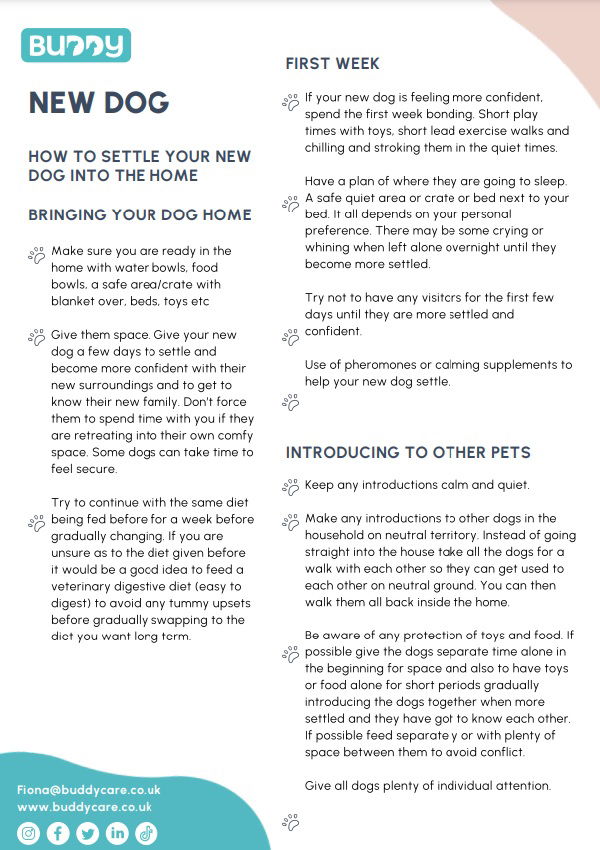New dog information

One of the best things you can do is rescue an older dog. However, it's crucial to keep in mind that every new best buddy has a unique tale to tell. Read our guide on how to settle your new dog into the home.
How to settle your new dog into the home
Bringing your dog home
Make sure you are ready in the home with water bowls, food bowls, a safe area / crate with blanket over, beds, toys etc
Give them space. Give your new dog a few days to settle and become more confident with their new surroundings and to get to know their new family. Don’t force them to spend time with you if they are retreating into their own comfy space. Some dogs can take time to feel secure.
Try to continue with the same diet being fed before for a week before gradually changing. If you are unsure as to the diet given before it would be a good idea to feed a veterinary digestive diet (easy to digest) to avoid any tummy upsets before gradually swapping to the diet you want long term.
First week
If your new dog is feeling more confident, spend the first week bonding. Short play times with toys, short lead exercise walks and chilling and stroking them in the quiet times.
Have a plan of where they are going to sleep. A safe quiet area or crate or bed next to your bed. It all depends on your personal preference. There may be some crying or whining when left alone overnight until they become more settled.
Try not to have any visitors for the first few days until they are more settled and confident.
Use of pheromones or calming supplements to help your new dog settle.
Introducing to other pets
Keep any introductions calm and quiet.
Make any introductions to other dogs in the household on neutral territory. Instead of going straight into the house take all the dogs for a walk with each other so they can get used to each other on neutral ground. You can then walk them all back inside the home
Be aware of any protection of toys and food. If possible give the dogs separate time alone in the beginning for space and also to have toys or food alone for short periods gradually introducing the dogs together when more settled and they have got to know each other. If possible feed separately or with plenty of space between them to avoid conflict.
Give all dogs plenty of individual attention.
Introducing to cats. This needs to be done very gradually until you can see how both the cat and the new dog are responding to each other.
Keep the new dog on a lead for the first introductions and allow the cat to have the ability to retreat to another room if they need to. Try to keep a little separate in the beginning.
If possible to allow access for the cat to retreat to another part of the home the dog does not have access to. Give lots of positive praise when both are calm and behaving well together.
Diet
Try to keep to the same diet as the new dog had previously for at least a week whilst they settle.
If the previous diet is unknown it would be good to give a veterinary digestive diet for at least a week before gradually swapping over to the long term food of your choice.
A high quality complete diet is recommended.
Stick to a set routine for mealtimes and the consistency with the food you are giving to encourage the new dog to eat and make it easier to settle into the new routine. Try to avoid lots of treats in the first week whilst they get into the routine of their mealtimes.
Flea and worming
Check the current flea and worming status of your new dog. If no treatments are known it would be advisable to get up to date with this.
Vaccinations and microchip
Check if up to date vaccinations have been done. If there is no vaccination book or passport or written evidence it would be advisable to get up to date with vaccinations with your local vet.
Please check to make sure the microchip is registered in your name. Sometimes the consent of the previous owner is required to do this. Your local vet can check the microchip details and let you know which company it is registered to. If the dog has come from outside the UK you can usually just register the microchip in the UK.

 Pet scams: How to protect yourself?This article will talk about the sneaky nature of pet scams and offer advice on how to stay safe from falling victim.
Pet scams: How to protect yourself?This article will talk about the sneaky nature of pet scams and offer advice on how to stay safe from falling victim. How to look after your pet while you're on holiday?When it comes to travel, it may appear as if dogs have a sixth instinct, especially when they aren't invited! During the pre-vacation flurry, Kitty may snuggle up to you the moment the luggage are packed, or your dog may appear unhappy.
How to look after your pet while you're on holiday?When it comes to travel, it may appear as if dogs have a sixth instinct, especially when they aren't invited! During the pre-vacation flurry, Kitty may snuggle up to you the moment the luggage are packed, or your dog may appear unhappy. Dog treatsDog treats are often used for training and rewarding dogs, but it's crucial to select healthy options and know how to use them properly.
Dog treatsDog treats are often used for training and rewarding dogs, but it's crucial to select healthy options and know how to use them properly.